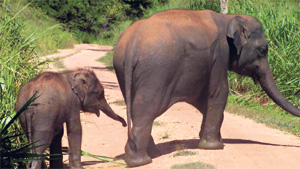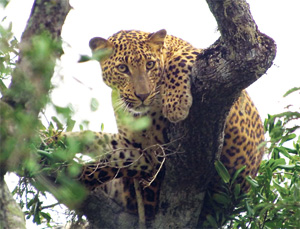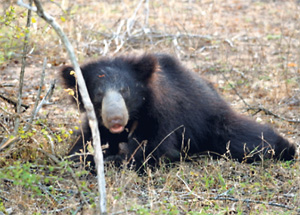Wildlife enthusiasts and tourists the world over are quite familiar with Africa’s “Big 5” the most sought after, highly visible, large and sometimes dangerous wild animals.
These are –the African Lion (Panthera leo), the African Elephant (Loxodonta africana & Loxodonta cyclotis ),Cape Buffalo (Syncerus caffer), Leopard (Panthera pardus) and African Black and White Rhinoceros(Diceros bicornis & Ceratotherium simum). A trip to the African parks is not complete if all these five animals have not been sighted. This has given rise to the brand “The Big 5 of Africa” which has now become synonymous with Africa’s wild life and tourism over the years.
Lately, Sri Lanka also has been leveraging its wildlife attractions as value additions to Sri Lankan Tourism promotion. Today, “The Gathering” of elephants at Minneriya National Park from May to October each year, is fast becoming a “must see” on the tourism itinerary. Whale watching off the Mirissa coast is also a popular tourist attraction. The fact that one can see the two largest mammals on this earth, the elephant and the whale in one and the same place, in Sri Lanka only, is another fact now being promoted.
In similar fashion, there is the possibility for the country to popularize and brand a group of animals that are quite exciting to view in the national parks of Sri Lanka.
They are the –
- Elephant ( Elephas maximus maximus)
- Blue Whale (Balaenoptera musculus)
- Leopard ( Panthera pardus kotiya)
- Sloth Bear ((Melursus ursinus inornatus)
Just like the African group of special interest animals, these Sri Lankan wild animals also have a certain allure which makes a close sighting of them in the wild, always an exhilarating experience. Hence, there is no reason why Sri Lanka cannot brand these animals together as a ‘must see’- ‘Sri Lanka’s Big 4’.
Sri Lanka’s Big 4
The Elephant
The most popular and abundant of the four (relatively speaking of course), the Sri Lankan elephant is a distinct subspecies from the mainland Asian elephants of India and Thailand. Although about 10,000 of these majestic creatures roamed most parts of our island at the turn of the century, only some 4000
(Santiapillai & Jackson 1990) or closer to 5000 now live in the wild today.
 |
| Pic by Srilal Miththapala |
Its sheer size ( it is the largest living land animal today in the world) and gentle demeanor have always made the elephant a much loved wildlife icon the world over. However, it is today classified as an endangered species (IUCN Red List) with about 150-200 elephants dying each year in Sri Lanka primarily due to the ‘Human Elephant Conflict (HEC).
Today the HEC situation has reached crisis proportions (there is an alarming increase of fatalities during the last few years with deaths exceeding 200 in a year), and urgently requires a coordinated national effort to solve this issue on a priority basis, if we are to save the elephant from extinction in the near future.
Pocketed herds are found in fragmented habitats today. The major wildlife parks all boast of elephant populations, with Uda Walawe perhaps having the largest concentration of both resident and transient elephants.
More of concern is that a good proportion of the wild population range outside the boundaries of the national parks. Considerable research has been done on Sri Lankan elephants and their behavioural patterns, by the likes of Eisenberg and Rudran in the past , and more recently by Santiapillai, Prithiviraj Fernando and a host of others.
Hence there is no shortage of local expertise but what is required is a national focus on the problem.
Of the Big 4 the elephant is the easiest to see, and already there are several established ‘elephant sighting safaris’ available in most of the wildlife parks.
Blue Whale
Blue whales are possibly the largest animals which ever lived on earth growing up to some 33 metres long, weighing up to some 150-180 metric tons. They live individually or in very small pods or groups and frequently swim in pairs.
In Sri Lanka, whale watching was first mooted in the 1980s following the documentation of whale sightings (blue whales and sperm whales) in Trincomalee. Subsequent security restrictions put paid to these initiatives. Today whale watching has been popularized and the preferred take off spot is Mirissa, deep down south.
It is believed that while some of the blue whales off Dondra Head/ Mirissa could be resident whales, others could be migratory ones crossing over to the Arabian Sea from the Bay of Bengal, during January, and then returning back in April
( Anderson. C ).
Whales, and particularly dolphins, are also sighted in the Kalpitiya area on the west coast.
The Leopard
Leopards are the top predators in Sri Lanka and are found in all types of forests: from thorn scrub and dry deciduous forests, to lowland rain forests and montane forests.
Leopards are large cats on average, weighing 37-90 kg for males and 28-60 kg for females. Until 1996 the leopard in Sri Lanka was considered the same as the Indian sub species, but research in 1996 by Dr. Sriyanie Miththapala led to it being classified as a separate sub species.
The mid 1990’s saw an increased interest in the island’s top carnivore: Rukshan Jayawardene and Gehan de S. Wijeyeratne have focused on photographing the leopard in Yala Block I and Jehan Kumara and Dr. Ravi Samarasingha’s BBC documentary ‘The Leopards of Yala’ put the leopard on the map.
While Perera, Kumara, Samarasingha focused on identifying individual leopards, Andrew Kittle and Anjali Watson began to study the population, behaviour and ecology of leopards in Yala Block I. Kittle and Watson’s study was extended to other parts of the island and showed that leopards were not only in national parks but living at the edge as well as outside protected areas.
Kittle and Watson’s study revealed that leopard density in Yala Block I is very high, which is why it is relatively easy to see a leopard in Yala. The Wilpattu National Park was also famed for its leopard population. All wildlife enthusiasts are eagerly awaiting their first forays into the park after its recent re-opening to ascertain the status of the leopard there.
Leopards are affected by habitat loss and poaching and are now listed as a threatened species by IUCN (2007).
Sloth Bear
 |
| Leopard and Sloth Bear.
Pix by Franklin Silva |
 |
The Sri Lankan Sloth Bear is the only species of bear found in Sri Lanka and, like the elephant, is a distinct subspecies, to the Indian species. The wild population is little as 1000 in many isolated areas, although it is only classified as ‘vulnerable’ ( IUCN Red List ). Destruction of dry-zone natural forest is its main threat. It is found relatively abundantly in the Yala and Wasgomuwa National Park. It was also distributed well in the Wilpattu National Park, where the current status, like in the case of all the animals in Wilpattu, has to be now freshly ascertained with the opening of the park after so many years.
Very little research has been done on Sri Lankan sloth bears. Among some of the main findings from a survey done during one of the few research studies, (Ratnayeke. S et al. 2005) was that sloth bear distribution is closely tied to remaining monsoon forests (also called open forest because of the relatively open canopy) of the dry lowlands in the northeast and southeastern parts of the island
The sloth bear will be perhaps the most elusive of the Big 4 and some organized efforts will have to put in place to popularize the sighting of this very interesting animal on regular game drives in the National Parks.
Timely branding
With tourism in Sri Lanka growing in leaps and bounds today ( January 2010 arrivals were up 32% compared to January 2009) it is important that we do not just sit back and rest on our laurels. What we are seeing is a pent-up demand for the destination, which was effectively ‘closed’ to the tourist world for many years. We need to spruce up our act, add value, refurbish and upgrade our product offering, and above all, create new niches to expand our markets from the ‘sun, sand, and sea’ segment, if we are going to sustain this momentum.
In this context Sri Lanka’s Big 4 is therefore a timely and useful branding initiative to popularize Sri Lanka’s natural wonders to the world.
|




